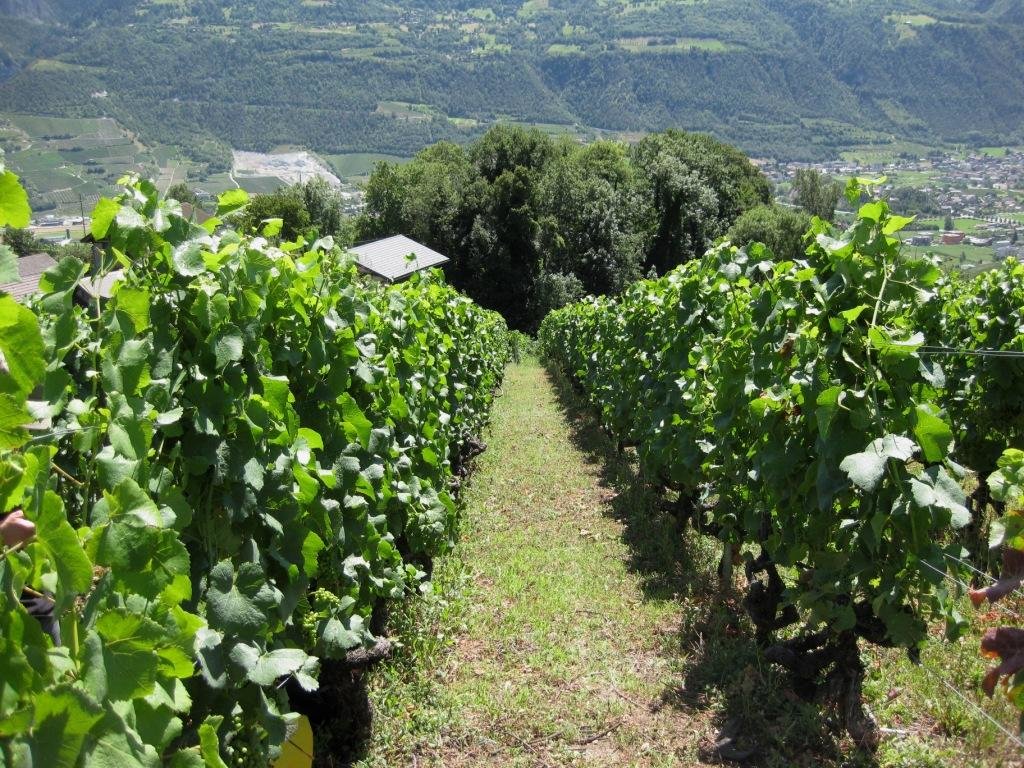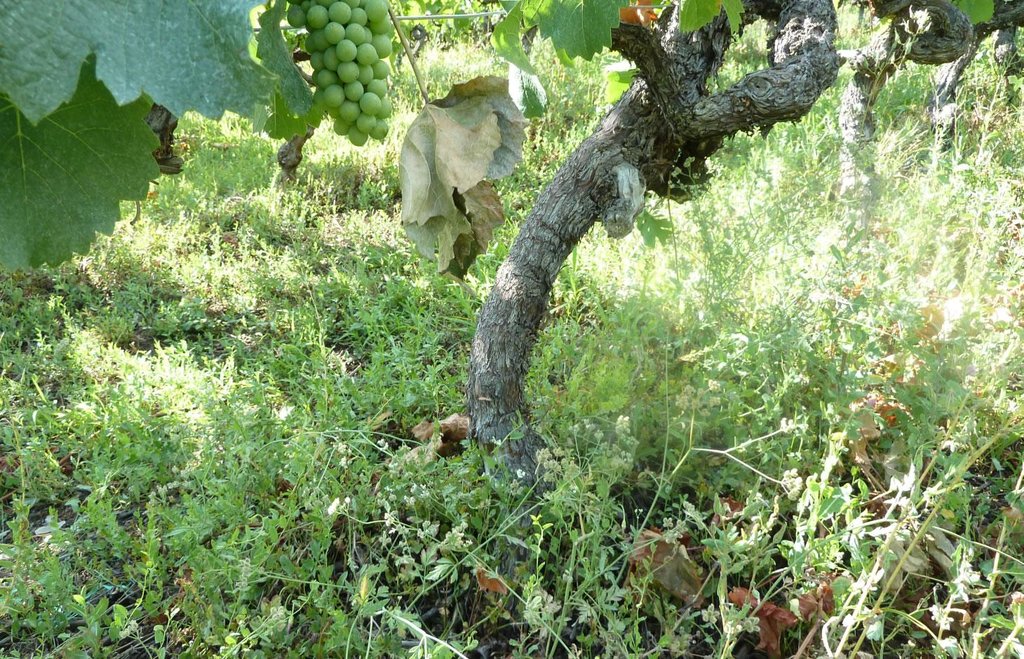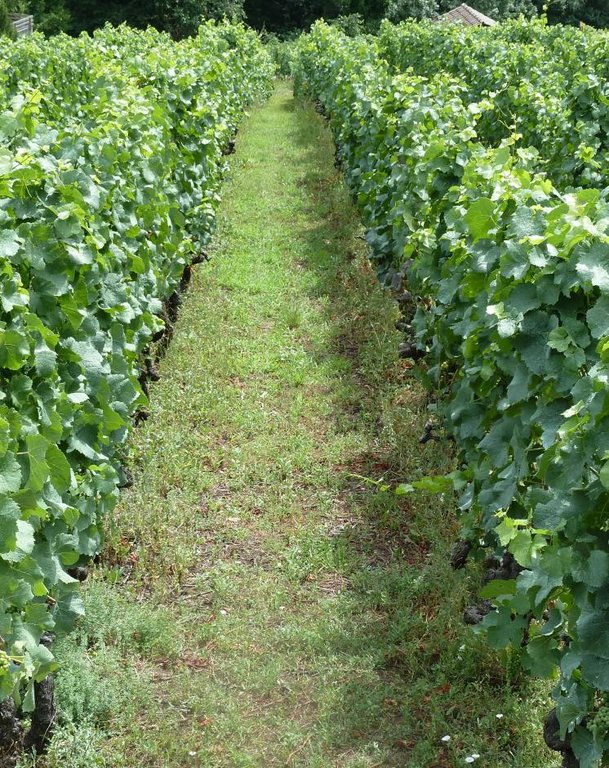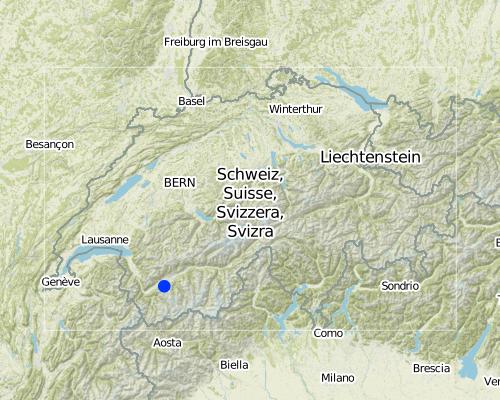Vineyard with natural grass cover in an arid alpine zone [Switzerland]
- Creation:
- Update:
- Compiler: Guillaume Grandchamp
- Editor: –
- Reviewer: Alexandra Gavilano
L’enherbement spontané des vignobles dans une zone montagneuse sèche (French)
technologies_1136 - Switzerland
- Full summary as PDF
- Full summary as PDF for print
- Full summary in the browser
- Full summary (unformatted)
- Vineyard with natural grass cover in an arid alpine zone: Dec. 28, 2016 (inactive)
- Vineyard with natural grass cover in an arid alpine zone: June 4, 2017 (inactive)
- Vineyard with natural grass cover in an arid alpine zone: June 5, 2017 (inactive)
- Vineyard with natural grass cover in an arid alpine zone: Aug. 14, 2019 (public)
View sections
Expand all Collapse all1. General information
1.2 Contact details of resource persons and institutions involved in the assessment and documentation of the Technology
land user:
Bagnoud Nicolas
+41 (0)79-303-18-71
info@bagnoudvins.ch
Bagnoud Vigneron
Encaveur Ch. du plat de Valençon 15, 3978 Flanthey – VS, Suisse
Name of project which facilitated the documentation/ evaluation of the Technology (if relevant)
Preventing and Remediating degradation of soils in Europe through Land Care (EU-RECARE )Name of the institution(s) which facilitated the documentation/ evaluation of the Technology (if relevant)
CDE Centre for Development and Environment (CDE Centre for Development and Environment) - Switzerland1.3 Conditions regarding the use of data documented through WOCAT
When were the data compiled (in the field)?
24/07/2012
The compiler and key resource person(s) accept the conditions regarding the use of data documented through WOCAT:
Yes
2. Description of the SLM Technology
2.1 Short description of the Technology
Definition of the Technology:
Establishment of natural grass cover in vineyards to reduce the use of herbicides and to increase biodiversity.
2.2 Detailed description of the Technology
Description:
A natural grass cover is left to develop in the vineyard. This should only be done once the vines are at least 4-5 years old because if done earlier, competition for water can negatively impact growth of the young vines. During the first years certain weeds are removed manually or through the targeted local application of herbicides. After a diverse grass cover has developed no herbicides are used in the vineyard anymore. There is no additional mulching applied, however, all the leaves and branches shed by the vines are left in the plot to decay and to replenish soil organic matter. In addition, the skins of grapes that remain after pressing are spread out on the plot as an organic fertilizer. In terms of inorganic fertilizers, potassium and magnesium are regularly applied to the vines. In some cases also nitrogen has to be applied because of competition for nitrogen between the vines and the grass cover, but this is avoided if possible. Wine quality can suffer from nitrogen insufficiency as it is needed for the fermentation process. Irrigation via a sprinkler irrigation system installed in the plot is only used during the establishment of the young vines. Later, no irrigation is used any more.
Purpose of the Technology: The main purpose of this technology is to reduce the use of herbicides, to improve soil structure and to promote an increase in biodiversity. A positive impact on reduced evaporation could not be confirmed by the land user as according to him, competition between the grasses and the vines for soil moisture is high. From the researcher’s point of view, the longer roots of the vines compared to those of the grasses should allow the vines to take up moisture from deeper layers and therefore the grass cover should at least have some positive effect on soil moisture. As soil erosion is not an important issue in this area, contrary to other vine producing areas in Switzerland, soil stabilisation is not a major purpose of this technology. However, the grass cover is naturally contributing to soil stabilisation which might still have a positive effect in the case of heavy rainfall events.
Establishment / maintenance activities and inputs: The choice of the plot on which grass cover should be established requires very high knowledge of its condition as on very dry soil there will be increase competition for water. Establishment activities are quite simple as the establishment of the grass cover is completely natural with no seeds added by the land user. Only during the first years of establishment, if needed, some contact herbicides are applied locally to prevent very common and aggressively spreading plants such as the dandelion (Taraxacum officinale) to spread and to impede the establishment of more rare species. In terms of maintenance the grass cover has to be cut. The frequency of cutting depends on the weather but is generally done about every 4-6 weeks. Cutting is alternating between lines in order to always retain seeds for reproduction within the system. The cutting is alternated between rows so that there is always a well-developed cover in at least part of the vineyard. Grass cutting is mechanised with specialised machinery needed to fit in between the vine rows. Because of the need for cutting this technology requires more labour than the common system used for vine cultivation (application of herbicides).
Natural / human environment: The hamlet of Valencon is situated on the right side of the Rhone River, in the central part of the Canton of Valais, in South-western Switzerland. The vineyard is located on a south facing slope at an altitude of about 700 m.a.s.l. The climate in the Rhone Valley is the driest in the whole of Switzerland with only about 500 mm of annual rainfall.
Because of increased labour need the farmer transfers the increased investment onto the price per bottle of vine. This is possible because the whole transformation process including sale takes place on farm. His mainly private customers are willing to pay a price premium for integrated production using less herbicides.
Although the interviewed land user is aware of around 10 other land users that have applied the technology, the spread of this technology is limited by the difficult topography which does not allow for mechanization in every case. It is also limited by conservative views about what a proper vineyard should look like (no grass in between the vines).
2.3 Photos of the Technology
2.5 Country/ region/ locations where the Technology has been applied and which are covered by this assessment
Country:
Switzerland
Region/ State/ Province:
Valais
Further specification of location:
Valençon (Chermignon)
Map
×2.6 Date of implementation
If precise year is not known, indicate approximate date:
- 10-50 years ago
2.7 Introduction of the Technology
Specify how the Technology was introduced:
- through land users' innovation
Comments (type of project, etc.):
Scientific research results were discussed among the vinegrower community.
3. Classification of the SLM Technology
3.2 Current land use type(s) where the Technology is applied

Cropland
- Tree and shrub cropping
Comments:
Major land use problems (compiler’s opinion): water scarcity, semi-arid zone, steep slopes, soils have relatively low water holding capacity, use of pesticides
Major land use problems (land users’ perception): mechanization difficult due to topography, decrease of plant biodiversity, use of pesticides
3.3 Further information about land use
Water supply for the land on which the Technology is applied:
- rainfed
Comments:
Water supply: rainfed, rainfed
Number of growing seasons per year:
- 1
Specify:
Longest growing period in days: 170
Longest growing period from month to month: May to October
3.5 Spread of the Technology
Comments:
Total area covered by the SLM Technology is 0,06 m2.
Currently the technology covers a surface of about 6 ha. The technology of complete cover is used on about 25% of the land user's total vineyards.
3.6 SLM measures comprising the Technology

agronomic measures
- A1: Vegetation/ soil cover
Comments:
Main measures: agronomic measures
Secondary measures: management measures
Type of agronomic measures: retaining more vegetation cover
Type of vegetative measures: in blocks
3.7 Main types of land degradation addressed by the Technology

soil erosion by water
- Wt: loss of topsoil/ surface erosion

chemical soil deterioration
- Cn: fertility decline and reduced organic matter content (not caused by erosion)
- Cp: soil pollution

biological degradation
- Bs: quality and species composition/ diversity decline

water degradation
- Ha: aridification
- Hq: decline of groundwater quality
Comments:
Main type of degradation addressed: Cp: soil pollution, Bs: quality and species composition /diversity decline
Secondary types of degradation addressed: Wt: loss of topsoil / surface erosion, Cn: fertility decline and reduced organic matter content, Ha: aridification, Hq: decline of groundwater quality
Main causes of degradation: crop management (annual, perennial, tree/shrub) (application of herbicides and pesticides (copper))
Secondary causes of degradation: governance / institutional (government regulations led to high use of pesticides in the 1970ies)
3.8 Prevention, reduction, or restoration of land degradation
Specify the goal of the Technology with regard to land degradation:
- reduce land degradation
- restore/ rehabilitate severely degraded land
Comments:
Main goals: mitigation / reduction of land degradation
Secondary goals: rehabilitation / reclamation of denuded land
4. Technical specifications, implementation activities, inputs, and costs
4.2 Technical specifications/ explanations of technical drawing
Technical knowledge required for field staff / advisors: low (Advisory system: Cantonal office for wine production provides assistance, but at the same time the land user feeds his results back to them, they distribute the newly gained knowledge to other farmers)
Technical knowledge required for land users: moderate (he needs to have good knowledge about the conditions of the plot where he wants to apply the technology, but not on the technology itself)
Main technical functions: improvement of ground cover, improvement of surface structure (crusting, sealing), improvement of water quality, buffering / filtering water
Secondary technical functions: control of raindrop splash, control of concentrated runoff: retain / trap, stabilisation of soil (eg by tree roots against land slides), increase in organic matter, increase / maintain water stored in soil, increase of biomass (quantity), promotion of vegetation species and varieties (quality, eg palatable fodder)
Agronomic measure: removing weeds
Material/ species: manually
Quantity/ density: 2 persons
Remarks: In the first years certain weeds are have to removed
In blocks
Vegetative material: G : grass
Grass species: natural grass
4.3 General information regarding the calculation of inputs and costs
other/ national currency (specify):
Swiss Frank
Indicate exchange rate from USD to local currency (if relevant): 1 USD =:
0.95
4.5 Costs and inputs needed for establishment
| Specify input | Unit | Quantity | Costs per Unit | Total costs per input | % of costs borne by land users | |
|---|---|---|---|---|---|---|
| Equipment | gazon naturel | 100.0 |
4.6 Maintenance/ recurrent activities
| Activity | Type of measure | Timing/ frequency | |
|---|---|---|---|
| 1. | cutting grass | Agronomic | 4-6 times / year |
| 2. | removing the weeds | Agronomic | once / year |
4.7 Costs and inputs needed for maintenance/ recurrent activities (per year)
| Specify input | Unit | Quantity | Costs per Unit | Total costs per input | % of costs borne by land users | |
|---|---|---|---|---|---|---|
| Labour | travail | 1.0 | 4000.0 | 4000.0 | 100.0 | |
| Total costs for maintenance of the Technology | 4000.0 | |||||
Comments:
Machinery/ tools: Grass cutter
4.8 Most important factors affecting the costs
Describe the most determinate factors affecting the costs:
Labour costs for grass cutting. An average labour cost of 300 CHF per day was assumed.
5. Natural and human environment
5.1 Climate
Annual rainfall
- < 250 mm
- 251-500 mm
- 501-750 mm
- 751-1,000 mm
- 1,001-1,500 mm
- 1,501-2,000 mm
- 2,001-3,000 mm
- 3,001-4,000 mm
- > 4,000 mm
Agro-climatic zone
- semi-arid
Thermal climate class: temperate
5.2 Topography
Slopes on average:
- flat (0-2%)
- gentle (3-5%)
- moderate (6-10%)
- rolling (11-15%)
- hilly (16-30%)
- steep (31-60%)
- very steep (>60%)
Landforms:
- plateau/plains
- ridges
- mountain slopes
- hill slopes
- footslopes
- valley floors
Altitudinal zone:
- 0-100 m a.s.l.
- 101-500 m a.s.l.
- 501-1,000 m a.s.l.
- 1,001-1,500 m a.s.l.
- 1,501-2,000 m a.s.l.
- 2,001-2,500 m a.s.l.
- 2,501-3,000 m a.s.l.
- 3,001-4,000 m a.s.l.
- > 4,000 m a.s.l.
5.3 Soils
Soil depth on average:
- very shallow (0-20 cm)
- shallow (21-50 cm)
- moderately deep (51-80 cm)
- deep (81-120 cm)
- very deep (> 120 cm)
Soil texture (topsoil):
- medium (loamy, silty)
Topsoil organic matter:
- medium (1-3%)
5.4 Water availability and quality
Ground water table:
5-50 m
Availability of surface water:
poor/ none
Water quality (untreated):
good drinking water
5.5 Biodiversity
Species diversity:
- medium
5.6 Characteristics of land users applying the Technology
Off-farm income:
- 10-50% of all income
Relative level of wealth:
- average
Individuals or groups:
- individual/ household
Level of mechanization:
- manual work
- mechanized/ motorized
Gender:
- men
Indicate other relevant characteristics of the land users:
Land users applying the Technology are mainly Leaders / privileged
Population density: < 10 persons/km2
30% of the land users are average wealthy and own 70% of the land.
Off-farm income specification: the main sourse is wine production from vineyard
Market orientation of production system: subsistence (self-supply), commercial/ market, commercial/ market
5.7 Average area of land owned or leased by land users applying the Technology
- < 0.5 ha
- 0.5-1 ha
- 1-2 ha
- 2-5 ha
- 5-15 ha
- 15-50 ha
- 50-100 ha
- 100-500 ha
- 500-1,000 ha
- 1,000-10,000 ha
- > 10,000 ha
Is this considered small-, medium- or large-scale (referring to local context)?
- medium-scale
5.8 Land ownership, land use rights, and water use rights
Land ownership:
- individual, titled
Land use rights:
- leased
- individual
Water use rights:
- communal (organized)
5.9 Access to services and infrastructure
health:
- poor
- moderate
- good
education:
- poor
- moderate
- good
technical assistance:
- poor
- moderate
- good
employment (e.g. off-farm):
- poor
- moderate
- good
markets:
- poor
- moderate
- good
energy:
- poor
- moderate
- good
roads and transport:
- poor
- moderate
- good
drinking water and sanitation:
- poor
- moderate
- good
financial services:
- poor
- moderate
- good
6. Impacts and concluding statements
6.1 On-site impacts the Technology has shown
Socio-economic impacts
Production
risk of production failure
Income and costs
expenses on agricultural inputs
workload
Quantity before SLM:
0%
Quantity after SLM:
10-20%
Socio-cultural impacts
health situation
cultural opportunities
conflict mitigation
Ecological impacts
Water cycle/ runoff
harvesting/ collection of water
Quantity before SLM:
not known
Quantity after SLM:
not known
evaporation
Quantity before SLM:
not known
Quantity after SLM:
not known
Soil
soil moisture
Quantity before SLM:
not known
Quantity after SLM:
not known
soil cover
Quantity before SLM:
0%
Quantity after SLM:
60-80%
soil loss
soil compaction
Biodiversity: vegetation, animals
biomass/ above ground C
plant diversity
animal diversity
beneficial species
habitat diversity
6.3 Exposure and sensitivity of the Technology to gradual climate change and climate-related extremes/ disasters (as perceived by land users)
Gradual climate change
Gradual climate change
| Season | Type of climatic change/ extreme | How does the Technology cope with it? | |
|---|---|---|---|
| annual temperature | increase | well |
Climate-related extremes (disasters)
Meteorological disasters
| How does the Technology cope with it? | |
|---|---|
| local rainstorm | not known |
| local windstorm | not known |
Climatological disasters
| How does the Technology cope with it? | |
|---|---|
| drought | well |
Hydrological disasters
| How does the Technology cope with it? | |
|---|---|
| general (river) flood | not known |
Other climate-related consequences
Other climate-related consequences
| How does the Technology cope with it? | |
|---|---|
| reduced growing period | well |
6.4 Cost-benefit analysis
How do the benefits compare with the establishment costs (from land users’ perspective)?
Short-term returns:
neutral/ balanced
Long-term returns:
positive
How do the benefits compare with the maintenance/ recurrent costs (from land users' perspective)?
Short-term returns:
neutral/ balanced
Long-term returns:
positive
Comments:
It takes time for the biodiversity to develop
6.5 Adoption of the Technology
- 10-50%
If available, quantify (no. of households and/ or area covered):
The land user is aware of about 10 other land users in the surroundings which apply this technology
Of all those who have adopted the Technology, how many have did so spontaneously, i.e. without receiving any material incentives/ payments?
- 90-100%
Comments:
There is a moderate trend towards spontaneous adoption of the Technology
Adoption will increase, however, the spread is limited by the difficult topography which does not allow for mechanization in every case. It is also a question of regional mentality. For some land users the growing of grass in between the vines makes the vineyards look badly kept.
6.7 Strengths/ advantages/ opportunities of the Technology
| Strengths/ advantages/ opportunities in the land user’s view |
|---|
|
Decreased use of herbicides and therefore contribution to ecosystem health. How can they be sustained / enhanced? Increase area of vineyards with grass cover. |
| Improved soil structure. |
| Increased plant and arthropode biodiversity. |
| Strengths/ advantages/ opportunities in the compiler’s or other key resource person’s view |
|---|
|
Simple to use technology as no specific inputs and knowledge is required. How can they be sustained / enhanced? Spread knowledge and encourage other vinegrowers to apply this technology. |
|
More sustainable production system beneficial for land users and the society as a whole. How can they be sustained / enhanced? Increase area of vineyards with grass cover. |
|
Increased biodiversity. How can they be sustained / enhanced? No use of herbicides in the future. |
| Une augmentation de la fertilité et de l'humidité du sol. |
6.8 Weaknesses/ disadvantages/ risks of the Technology and ways of overcoming them
| Weaknesses/ disadvantages/ risks in the land user’s view | How can they be overcome? |
|---|---|
| Increased competition between grasses and vines can lead to decreased grape quality. | The land user needs to have very good knowledge about the plot conditions in order to know where competition can be supported; select only grass species which are less competitive; only apply partial grass cover. |
| Need for mechanization, which is not feasible on every plot due to topography. | Only apply grass cover on flatter plots which allow for mechanization. |
| Increased frost can have a devastating impact on grapes. This can be a severe disadvantage but in this case is only a problem for vineyards in the valley planes, not for those on the slopes. | Cut grass cover as low down as possible before frost occurs (however, the exact moment is difficult to anticipate). |
| Weaknesses/ disadvantages/ risks in the compiler’s or other key resource person’s view | How can they be overcome? |
|---|---|
| Increased frost can have a devastating impact on grapes which can be a severe disadvantage. In this case it is only a problem for vineyards in the valley planes, not for those on the slopes. | Cut grass cover as low down as possible before frost occurs (however, exact moment is difficult to anticipate). |
Links and modules
Expand all Collapse allLinks
No links
Modules
No modules






